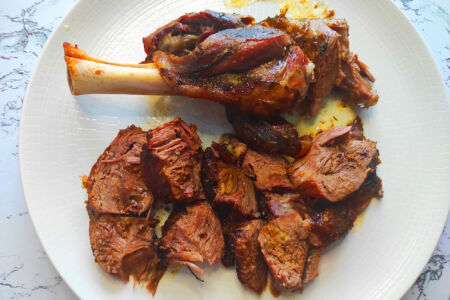Classic Hungarian Plum Dumplings
Hungarian cuisine is known for its rich and diverse flavors, and one delectable treat that perfectly exemplifies this is “Szilvás Gombóc,” or Hungarian Plum Dumplings.
These sweet and satisfying dumplings have a fascinating history and origin deeply rooted in Hungarian traditions.
History and Origin
The history of Szilvás Gombóc is a testament to the fusion of cultural influences in Hungary. These plum dumplings, which are now considered a classic Hungarian dessert, have evolved over centuries.
The origin of plum dumplings can be traced back to the Middle Ages when Hungary was part of the Austro-Hungarian Empire. During this time, Hungarian cuisine absorbed influences from various neighboring regions.
The concept of dumplings made with fruit, such as plums, was influenced by the culinary traditions of the Balkans and Austria.

| Prep time | Cook Time | Rest Time | Total Time |
|---|---|---|---|
| 40 min | 15 min | - | 55 min |
Plums were especially abundant in Hungary, and this led to their integration into local dishes. The earliest versions of Szilvás Gombóc were likely made with simple dough and plums.
Over time, as the recipe evolved, potatoes were incorporated into the dough, providing a softer, more delicate texture.
The dumplings
were traditionally made during the plum harvest season in late summer, celebrating the bounty of fresh, juicy plums.
As Hungary moved through its tumultuous history, Szilvás Gombóc remained a beloved comfort food that brought families together.
Today, Hungarian Plum Dumplings continue to hold a special place in Hungarian culture. They are served as a dessert or snack and are a popular choice for family gatherings and special occasions.
The sweet and tart flavors of plums, enhanced by a dusting of sugar and sometimes a hint of cinnamon, make these dumplings a delightful treat.

Hungarian Plum Dumplings
have also gained international recognition and are appreciated by people around the world who seek the unique and delightful tastes of Hungarian cuisine.
In conclusion, Szilvás Gombóc, or Hungarian Plum Dumplings, are a delicious and historic dessert that reflects Hungary’s rich culinary heritage.
Their journey through time and cultural influences has resulted in a beloved dish that continues to satisfy sweet cravings and create lasting memories for generations of Hungarian families and food enthusiasts worldwide.
Ingredients
Instructions
Prepare the Dough
Peel and mash the boiled potatoes while they are still warm.
In a large bowl, combine the mashed potatoes, flour, egg, butter and a pinch of salt.
Knead the mixture until a soft, smooth dough forms. If the dough is too sticky, you can add a little more flour.
Shape the Dumplings
Take a small portion of the dough and flatten it in the palm of your hand.
Place a halved plum in the center, add 1 teaspoon of sugar on top of the plums and a pinch of cinnamon (optional) then wrap the dough around the plum, forming a ball.
Make sure there are no openings for the plum to escape during cooking.
Boil the Dumplings
Bring a large pot of salted water to a boil.
Gently place the plum dumplings in the boiling water.
They will sink at first, and when they rise to the surface, cook for an additional 5-7 minutes.
Remove them using a slotted spoon.
While the dumplings are still warm, roll them in breadcrumbs to coat them evenly.
Serve the plum dumplings with a sprinkle of icing sugar.
Enjoy, Good Appetite!











